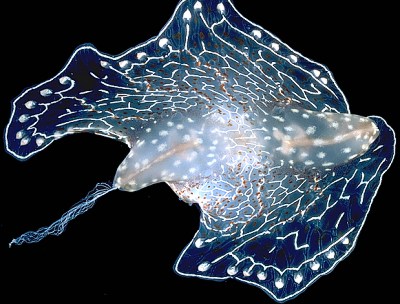
Benthic ctenophores
PHOTO
A benthic ctenophore, Coeloplana sp?. Note partially everted set of tentacles. Off East Point, 6m, Darwin, Northern Territory, Australia. June 1987. PHOTO: Bill Rudman.
Ctenophores, commonly called Comb Jellies or Sea Gooseberries, were previously considered to be Cnidarians, because like jelly fish and sea anemones, ctenophores also have nematocysts. Today they are considered to represent a separate Phylum, the Ctenophora. Most are pelagic animals, spherical in shape, which swim by bands of large beating cilia, arranged in vertical rows, each band being likened to comb, hence the name "Comb Jelly". The 'jelly' is a reference to Jelly Fish. Ctenophores catch their prey by everting two groups of stinging and sticky tentacles.
There are however a small group of ctenophores [Platyctenida] which have evolved into benthic 'slugs'. At first glance they are usually considered to be flatworms, but if you look at them carefully you will find a pair of pores or swellings which indicate the chambers in which are stored the stinging tentacles. Quite often found on soft corals, like acoel flatworms, there are only a few described species, but probably many yet to be recognised. Most are less than 10-15mm long.
See report of aglajid opisthobranch eating a benthic ctenophore [message #15543 ]
Authorship detailsRudman, W.B., 1999 (November 25) Benthic ctenophores. [In] Sea Slug Forum. Australian Museum, Sydney. Available from http://www.seaslugforum.net/find/ctenopho
Related messages
Benthic ctenophores from Bali
October 27, 2008
From: Supapong Areeprasertkul
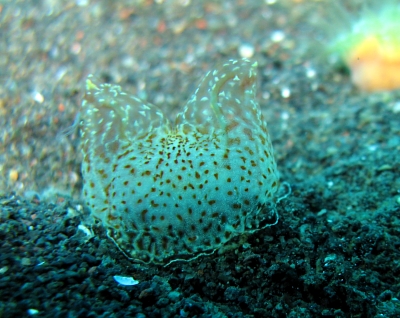
This is a stuff I have no clue what kind of animal it could be. Although it seems not to have organs like any nudibranch, I hope it would be a kind of sea slug so I sent this to you. Please let me know if you have any idea.
Locality: Beach, 10 metres, Puri Jati, Bali, Indonesia, Bali, 16 August 2007, Sandy bottom. Length: 2 - 3 cm. Photographer: Supapong Areeprasertkul.
Thanks,
Supapong Areeprasertkul
zybersup@gmail.com
Supapong, A., 2008 (Oct 27) Benthic ctenophores from Bali. [Message in] Sea Slug Forum. Australian Museum, Sydney. Available from http://www.seaslugforum.net/find/20530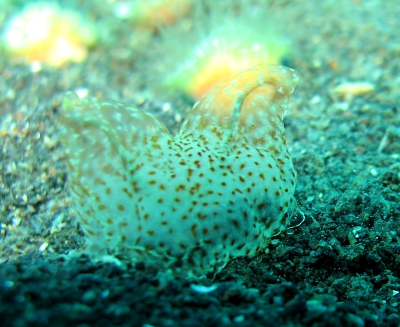
Dear Art,
These are not slugs, but because they look like they could be, I have a page for them on the Forum. They are benthic Ctenophores. These animals, also called 'Comb Jellies' or 'Comb Jellyfish' are usually pelagic animals found swimming or drifting in the plankton. They have a pair of long branched tentacles for entangling their prey which can be retracted into sacs in their body. Your animal is one of a small group which live sedentary non-swimming lives attached to the sea floor or objects. The two 'ear-like' structures in your animal are the sacs into which the tentacles retract. Have a look at the Fact Sheet and the other messages attached, as until quite recently, this was the only site in the world with photos of the fascinating animals.
Best wishes,
Bill Rudman
Benthic ctenophore from Bali
June 20, 2006
From: Ovidiu
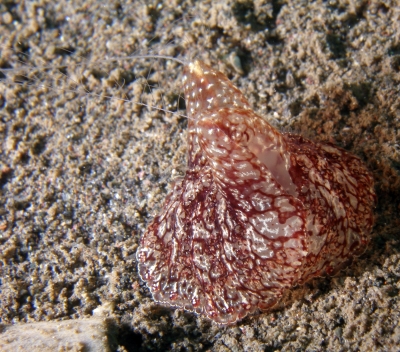
I am trying to identify the slug(?) in the attached images. We encountered them in Bali (Indonesia) in May'06 and cant find it in any books. We call it "rabbit" (resemblance to the rabbits ears?)
Locality: Bali, aprox 18m, Bali, Indonesia , South China Sea, May 2006, Volcanic sandy bottom. Length: 8-10cm. Photographer: Ovidiu.
Hopefully someone can help to identify it.
Thanks,
Ovidiu
ovidiumg-uw@yahoo.com
Ovidiu, 2006 (Jun 20) Benthic ctenophore from Bali. [Message in] Sea Slug Forum. Australian Museum, Sydney. Available from http://www.seaslugforum.net/find/16910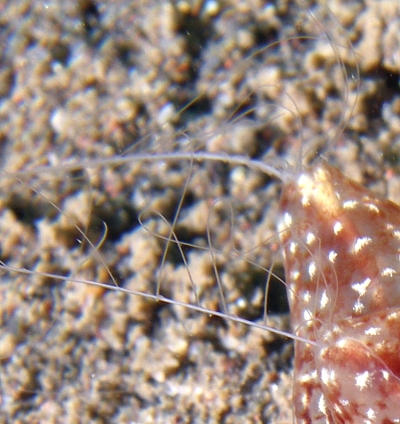
Dear Ovidiu,
Although it's not a slug, it does looks a bit like one, so I have a Fact Sheet on these fascinating animals - the benthic ctenophores. One good character are the pair of volcano-like mounds out of which the branched feeding tentacles emerge. You can see part of the tentacles in the close-up alongside. Have a look at the other messages on this topic for more photographs. Up until now, the Forum is the only place on the web where you will find many photos of these animals.
Best wishes,
Bill Rudman
Re: Aglajid eating a benthic ctenophore
January 14, 2006
From: Brian Francisco
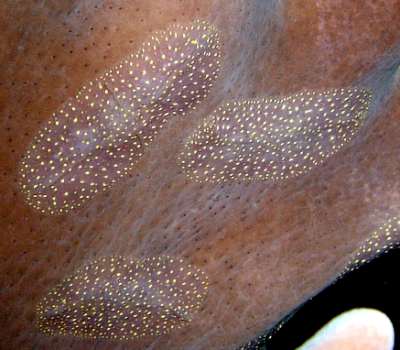
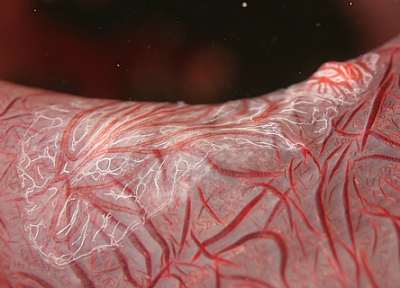
Concerning message #15543:
Bill
Thank you very much for the prompt reply and invaluable information regarding the "Aglajid eating a benthic ctenophore". As you said in your reply, finding information about benthic ctenophores on the web is rather difficult. So here are a few more photos for your files of two species found on soft corals here in East Timor.
Locality: East Timor, Banda Sea. Depth: 8M & 16M. Length: 2mm - 25 mm, December 2005. sandy slope. Photographer: Brian Francisco
Notice in the upper right side of the second photo there appears to be a smaller ctenophore individual atop the larger.
Thanks again
Brian
uwet.blogspot@gmail.com
Francisco, B., 2006 (Jan 14) Re: Aglajid eating a benthic ctenophore. [Message in] Sea Slug Forum. Australian Museum, Sydney. Available from http://www.seaslugforum.net/find/15558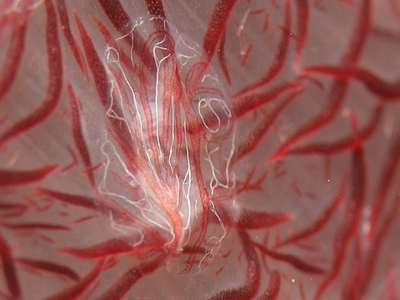
Dear Brian,
I wish I could reply to all messages as promptly. They are certainly fascinating animals, and as we can see in your photos, some, like nudibranchs, have become the masters of disguise.
Best wishes,
Bill Rudman
Can you identify this one?
January 12, 2006
From: Karen Christensen
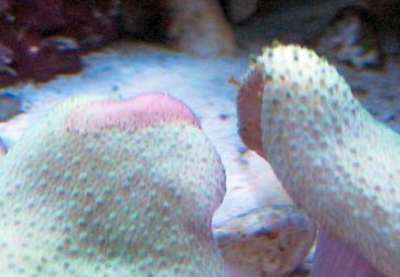
Bill is this a slug or a flatworm?
I know it's not the best picture in the world, but it's all I have. I have three of these creatures that came on this piece of coral. They extend a "fishing line" at night that has several little lines coming off of the main line. The retract and launch several times as if feeding or "fishing" for food. It takes on the color of its surroundings.
I currently have three of them in my tank with other corals and need to know if they can stay or need to be put in their own tank.
Thank you so much for your assistance.
Karen Christensen
Brooklyn, WI, USA
ruhogwild@charter.net
Christensen, K., 2006 (Jan 12) Can you identify this one?. [Message in] Sea Slug Forum. Australian Museum, Sydney. Available from http://www.seaslugforum.net/find/15526Dear Karen,
I guess I should just say I don't know. You don't give me any clues where the animals come from. I guess WI stands for Wisconsin so I guess they aren't from your home state.
I can't see enough detail to be sure what phylum they belong to but your description of them extending a fishing line with little lines off it makes me wonder if you have some benthic ctenophores. If so they should produce a string at each end of the body. Have a look at the photos and messages on the benthic ctenophore Fact Sheet and see if they look similar. There are good photos of some from Turkey with their 'fishing lines' extended.
Best wishes,
Bill Rudman
A benthic ctenophore from the Philippines
February 24, 2004
From: Mabel Fang
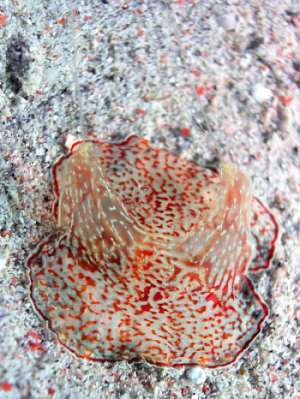
Dear Bill
I found this gelatinous-looking slug on a muck dive in Puerto Galera, Philippines. It seems to be secreting some threads from its 'twin peaks'.
Could you please help us identify and explain this behaviour?
Depth: 30 feet
Temp: 23 degree celsius
Date: 23 Jan 2004
Regards
Mabel Fang
phillau@singnet.com.sg
Fang, M., 2004 (Feb 24) A benthic ctenophore from the Philippines. [Message in] Sea Slug Forum. Australian Museum, Sydney. Available from http://www.seaslugforum.net/find/12274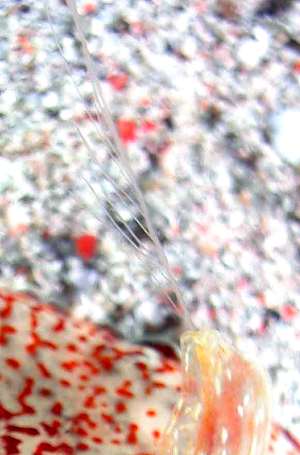
Dear Mabel,
This is 'slug' is not a mollusc. It is a very strange member of the phylum Ctenophora. The most common members of this phylum are small planktonic animals called Comb Jellies which have a pair of long branches tentacles for catching their prey. The platyctene ctenophores are a small group which no longer swim, and are flattened to look much like a slug or flat worm. Some live directly on the sea floor while others live on plants or sessile animals. They can be recognised buy the pair of branched tentacles which usually have a pointed sac in which they can retract - your 'twin peaks'.
Your animal is probably a species of Coeloplana. Although not a real sea-slug, these are very interesting animals. They are seldom photographed and usually misidentified as strange flat worms.
Best wishes
Bill Rudman
An organism on Caulerpa prolifera
December 19, 2003
From: Levent Cavas
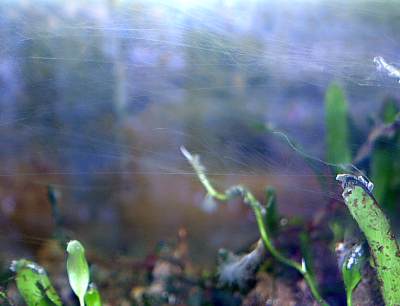
Dear Sir,
I saw an interesting organism on Caulerpa prolifera in my aquarium. Some parts of fronds were destroyed by this organism.
Do you know what it is?
Best regards,
Levent Cavas
Research Assistant
Dokuz Eylul University
Department of Biochemistry
Kaynaklar Campus, Izmir
Turkey
http://people.deu.edu.tr/lcavas
lcavas@hotmail.com
![]()
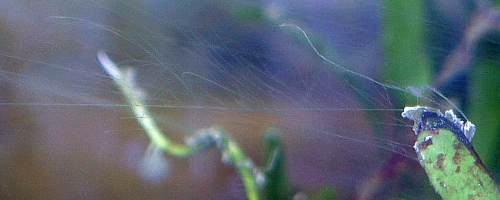
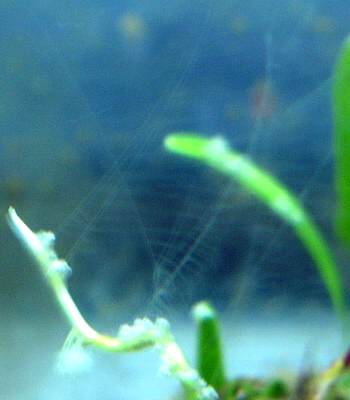
Dear Levent,
I've had a look at your photos and I guess what you are interested in are the 'things' producing the long spiderweb-like threads in the water? If so, my only guess is that they are benthic ctenophores. I have a photo in the Forum of a tropical species in which the long threads are retracted. The threads are used to catch small planktonic animals.
If my guess is correct, then you should be able to poke one off the Caulerpa and have a look at it. Each animal should produce 2 threads. I'm not an expert on ctenophores so I could of course be quite wrong. I don't even know if benthic ctenophores occur in the Mediterranean. Let me know what you think
Cheers
Bill
What is this 'red thing' on Halgerda?
November 26, 1999
From: Valda Fraser
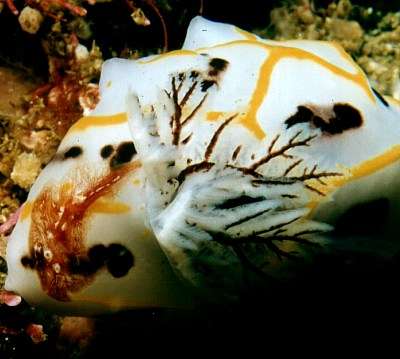
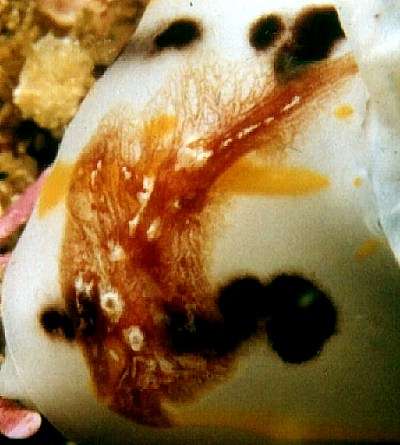
Dear Bill
What is the "red thing" on this Halgerda ? I hope you will be able to help.
Locality: South Coast KwaZulu-Natal, SOUTH AFRICA. Scottburgh - Rocky reef - 20m. November 1999. Size of Halgerda: 50mm
Regards
Valda Fraser
iti04937@mweb.co.za
Fraser, V., 1999 (Nov 26) What is this 'red thing' on Halgerda?. [Message in] Sea Slug Forum. Australian Museum, Sydney. Available from http://www.seaslugforum.net/find/1585Dear Valda,
Your 'red thing' looks quite like a flatworm but I don't think it is.
I think it is a benthic, or bottom-dwelling ctenophore. Have a look at the page I have just prepared on these strange animals - I don't often have an excuse to show my photo of these animals. There are two reasons why I think it is a ctenophore, not a flatworm. See the two white eye-like rings? I think they are the pores through which the feeding tentacles are shot out. Secondly you can clearly see a network of tubes throughout the tissue. If you look at my photo of Coeloplana sp? you will see an identical network of tubes.
Any other views, agreeing or disagreeing are welcome.
Bill Rudman.
Rudman, W.B., 1999 (Nov 26). Comment on What is this 'red thing' on Halgerda? by Valda Fraser. [Message in] Sea Slug Forum. Australian Museum, Sydney. Available from http://www.seaslugforum.net/find/1585